

Sampling (music) Originally developed by experimental musicians working with musique concrète and electroacoustic music, who physically manipulated tape loops or vinyl records on a phonograph by the late 1960s, the use of tape loop sampling influenced the development of minimalist music and the production of psychedelic rock and jazz fusion.
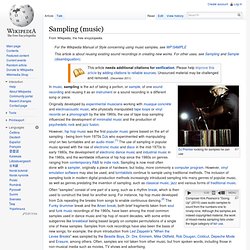
Composer Kirk Pearson's "Going Up" (2010) uses audio samples to count from the numbers one to ninety-nine. Although the samples are indeed copyrighted material, the work of mixed-media sampling falls under the legal category of fair use. The use of sampling is controversial legally and musically. Experimental musicians who pioneered the technique in the 1940s to the 1960s sometimes did not inform or receive permission from the subjects of their field recordings or from copyright owners before constructing a musical piece out of these samples. Aside from legal issues, sampling has been both championed and criticized.
Monkey Magic (TV series) Kongo (Sun Wukong or Goku) Kongo stars as the main character within the Japanese anime series Monkey Magic.
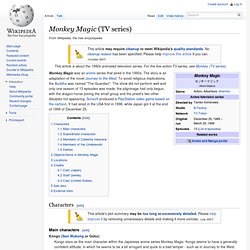
Kongo seems to have a generally confident attitude, in which he seems to be a bit arrogant and quick to a bad temper - such as in Journey to the West. Monkey Magic (PlayStation game) Monkey magic at game FAQs.
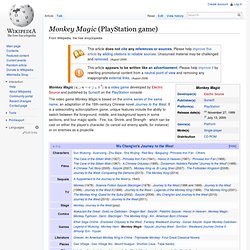
Monkey (TV series) Saiyūki (西遊記?)
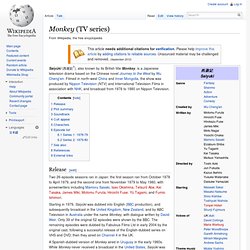
, also known by its British title Monkey, is a Japanese television drama based on the Chinese novel Journey to the West by Wu Cheng'en. Filmed in north-west China and Inner Mongolia, the show was produced by Nippon Television (NTV) and International Television Films in association with NHK, and broadcast from 1978 to 1980 on Nippon Television. Monkey conquers heaven. 1985 'Monkey King Conquers Evil' Chinese Animation 金猴降妖. Monkey meets Buddha. Monkey King Subdued the Evil DVD. The Legend of Zelda:Twilight Princess Music- Monkey King. Monkey (zodiac) List of Oz books. The Oz books form a book series that begins with The Wonderful Wizard of Oz (1900) and relate the fictional history of the Land of Oz.
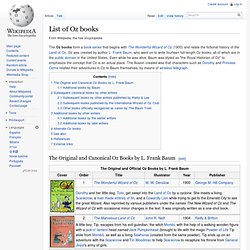
Oz was created by author L. Frank Baum, who went on to write fourteen full-length Oz books, all of which are in the public domain in the United States. Even while he was alive, Baum was styled as "the Royal Historian of Oz" to emphasize the concept that Oz is an actual place. The illusion created was that characters such as Dorothy and Princess Ozma related their adventures in Oz to Baum themselves, by means of wireless telegraph. Winged monkeys. Details[edit] In the original Oz novels, winged monkeys were just what the name implies: intelligent monkeys with bird-like wings.
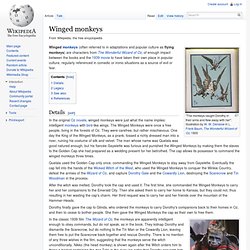
The Winged Monkeys were once a free people, living in the forests of Oz. They were carefree, but rather mischievous. Monkey. A monkey is any nonhuman primate, with the usual exception of the lemurs and tarsiers.[1] Thus defined, there are three type of monkeys: (1) non-human hominoids (also known as apes), (2) old world monkeys, and (3) new world monkeys.
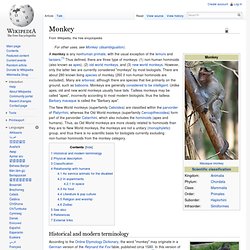
However, only the latter two are currently considered "monkeys" by most biologists. There are about 280 known living species of monkey (260 if non-human hominoids are excluded). Many are arboreal, although there are species that live primarily on the ground, such as baboons. Monkeys are generally considered to be intelligent. Unlike apes, old and new world monkeys usually have tails. Magical Sentosa. Sentosa - The Musical Fountain - Part 1. Three wise monkeys. Signifying monkey. The Signifying Monkey is a character of African-American folklore that derives from the trickster figure of Yoruba mythology, Esu Elegbara.
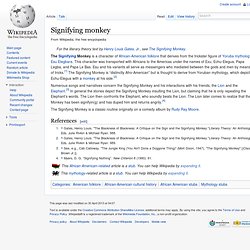
This character was transported with Africans to the Americas under the names of Exu, Echu-Elegua, Papa Legba, and Papa Le Bas. Esu and his variants all serve as messengers who mediated between the gods and men by means of tricks.[1] The Signifying Monkey is “distinctly Afro-American” but is thought to derive from Yoruban mythology, which depicts Echu-Elegua with a monkey at his side.[2] The Signifying Monkey. Critical reception[edit] Upon publication in 1988, The Signifying Monkey received both widespread praise and notoriety.

Prominent literary critic Houston A. Baker wrote that it was “a significant move forward in Afro-American literary study”[6] and Andrew Delbanco wrote that it put Gates “at the forefront of the most significant reappraisal of African-American critical thought since the 1960s.”[7] It won an American Book Award in 1989. Signifying Rappers: Rap and Race in the Urban Present. Title[edit] Publication history[edit] The work was initially published as a shorter 20 page essay in (Wallace & Costello 1990), and then expanded to book size and the first edition published in late 1990.
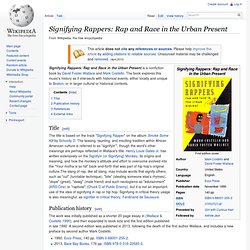
A second edition was published in 2013, following the death of the first author Wallace, and includes a new preface by second author Mark Costello. References[edit] External links[edit] Four Great Classical Novels. The Four Great Classical Novels[1] of Chinese literature (Chinese: 四大名著, Sìdàmíngzhù, lit. "Four Great Masterpieces") are the four novels commonly regarded by Chinese literary criticism to be the greatest and most influential of pre-modern Chinese fiction. Dating from the Ming and Qing dynasties, they are well-known to most Chinese either directly or through their many adaptations to opera and various popular cultural medium. They are among the world's longest and oldest novels[2] and are considered to be the pinnacle of China's achievement in classical novels, influencing the creation of many stories, plays, movies, games, and other forms of entertainment throughout East Asia, including China, Japan, Korea, and Vietnam.
Works[edit] In chronological order, they are: Background[edit] Journey to the West. The novel is an extended account of the legendary pilgrimage of the Tang dynasty Buddhist monk Xuanzang who traveled to the "Western Regions", that is, India, to obtain sacred texts (sūtras) and returned after many trials and much suffering. It retains the broad outline of Xuanzang's own account, Great Tang Records on the Western Regions but the Ming dynasty novel adds elements from folk tales and the author's invention, that is, that the Buddha gave this task to the monk and provided him with three protectors who agree to help him as an atonement for their sins.
These disciples are Sun Wukong, Zhu Bajie, and Sha Wujing, together with a dragon prince who acts as Xuanzang's steed, a white horse. Monkey (TV series) Sun Wukong. One of the most enduring Chinese literary characters, Sun Wukong has a varied background and colorful cultural history. For example, Sun Wukong is considered by some scholars to be influenced by both the Hindu deity Hanuman from the Ramayana and elements of Chinese folklore.[2][3][4] Background[edit] Birth and early life[edit] Mind monkey.
Mind monkey or monkey mind, from Chinese xinyuan and Sino-Japanese shin'en 心猿 [lit. "heart-/mind-monkey"], is a Buddhist term meaning "unsettled; restless; capricious; whimsical; fanciful; inconstant; confused; indecisive; uncontrollable". In addition to Buddhist writings, including Chan or Zen, Consciousness-only, Pure Land, and Shingon, this "mind-monkey" psychological metaphor was adopted in Daoism, Neo-Confucianism, poetry, drama, and literature. "Mind-monkey" occurs in two reversible four-character idioms with yima or iba 意馬 [lit. "thought-/will-horse"], most frequently used in Chinese xinyuanyima 心猿意馬 and Japanese ibashin'en 意馬心猿.
Monkey: Journey to the West. Monkey: Journey to the West is a stage adaptation of the novel Journey to the West by Wu Cheng'en. It was conceived and created by the Chinese actor and director Chen Shi-zheng along with British musician Damon Albarn and British artist Jamie Hewlett. Development[edit] In 2004, Chinese opera director Chen Shi-zheng approached Jean-Luc Choplin of the Théâtre du Châtelet, Paris, about staging an opera based on Wu Cheng'en's 16th-century novel Journey to the West. Chen had worked with the writer David Greenspan on an outline dramaturgy, but had not identified a composer for the project. Journey to the West (1986 TV series) A Supplement to the Journey to the West. At the end of the novel, the author lists twelve hypothetical questions that a reader might ask and answers them.
For instance, he explains that the reason why he wrote the Supplement is because he wanted Monkey to face an opponent—in this case desire—that he could not defeat with his great strength. Saiyuki.